Talk
December 31, 2019 – "President"
It's afternoon. My view is over bucolic fields. The sun is out today, but soon it will go – and not return until next year. No snow on the ground. It becomes really dark, when it's dark.
I just came back from a run through the hilly landscape. So beautiful. While I ran I listened to first this podcast from the Guardian, which centered around an interview with Greta Thunberg from back in March. As ever, with her, asthonishing – on a number of levels. Then I continued with a podcast (in Swedish by climate scientist Johan Rockström (English version here), who is the director of the prestigious Potsdam Institute for Climate – and one of the scientists Thunberg is in close contact with.
Listening to Rockström is really hard. He definitely has the gift of speech, like Thunberg, but he IS one of those scientists and he is (close to) my age. Hence, there are less distractions and less hope. When Thunberg speaks her message might be even starker, but the fact of her age and meteoric rise in worldwide attention, becomes a factor of hope, just by its own example. Which is, of course, valuable – because whatever happens we always need to retain hope.
The coming year will be crucial in so many ways. Millions will observe and speculate about Thunberg's further initiatives and trajectory. While I ran, I had this stray thought: "wonder how many writers are working right now on future scenarios, where an adult Greta has become the president of ...?"
-----
Only after I already posted the above, did I look at my last two posts and realize that I finished 2019 writing repeatedly about Greta Thunberg – not even being aware of it. It's almost embarrassing. At the same time I guess I explained the reason why this happens, before I noticed.
December 13, 2019 – "Friday 13th"
It's Friday the 13th and this good day's news are all about Boris Johnson winning big in Great Britain's election. What else could you expect? Except one should have been able to expect anything but this result, given that said Johnson is an inveterate liar with no sense of responsibility for anyone but himself. Sounds familiar? To answer my first question I can only say, with sadness: look at the competition.
Meanwhile, to follow up on my last post, yesterday that famous friend of Johnson's, the "stable genius" known for his "infinite wisdom", chose to use his Twitter account for an "ironic" but personal attack on the teenage activist. Only to see her turn his attack around like a true judoka and gain even more world wide attention and personal respect as a result. Sadly, while this is gratifying, it is also just a diversion.
Which we can't afford.
December 11, 2019 – "Speech"
The news just came that Time Magazine has named Greta Thunberg its Person of the Year. It's astonishing and at the same time not at all surprising. I don't think it is wrong, but at the same time, the fact that it is not, just shows how deep the problem is, that she is addressing (and she did speak, also today, at the UN climate conference in Madrid). Like Greta would be the first person to say, her voice and activism would not be needed, if the adults – society – would behave responsibly in accordance with the available information. But they –we – are too weak / too selfish / too overwhelmed to do so, leaving so many of us depressingly aware of our failure and hoping for others to compensate for it. Then appears a young girl with an amazing determination and an amazing talent for speech and leadership. An ability to communicate what so many know to be true, even if they choose to fight this knowledge.
Through the ages, this is how religions have gotten started.
December 6, 2019 – "Making"
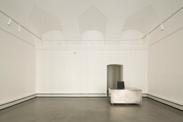
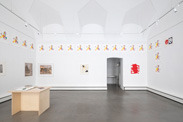
I have added the documentation for my exhibition in Vienna: "Making Prints and Thinking About It". It became a beautiful show, for which I played around with all the prints I have made since 1985, selecting a certain number, not in order to prove any points (which is, perhaps, what I try to do in the eponymous book). Instead, I combined the images to create some sort of story... which I can't relate in any other way. I first built a small model of the room, in which I pinned scale cut-outs until I had found a structure. Then I drew the walls in photoshop and pasted the images very exactly in their places, so that I would not need to deal with lots of decisions during the installation. It worked perfectly. I was greatly helped by having received from the gallery in advance, beautiful and austere photos of the empty space. I always had a soft spot for really precise architecture photography and in these minimal photos I saw unusual qualities which are impossible to pin down precisely, but which influence you nevertheless. The day after the opening (which was great, it was packed) I met the photographer, Eva Kelety. She came to shoot the no longer empty room , including portraits of me. It was a pleasure to watch her work, and I learned something valuable. Eva used only natural light, which I thought would not be enough, because the room was really rather dusky. But... she knew her stuff and she was thinking digital, whereas my thinking was still related to analog exposures. Eva used the necessary long exposure times and fixed the raw files' white balance in software later. The result: perfect light. Such a simple thing, but with my analog upbringing I had never thought this was a possibility. Now I know. And for the first time here on this site, the installation photos of one of my shows have been made by somebody else than me. With permission, of course.
November 18, 2019 – "Thinking
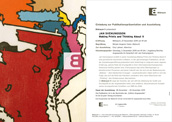
Next week, on Wednesday 25.11, a show of mine will open in Vienna. It will feature prints from 1985 to 2018... yet it is not a retrospective, but a serious and playful installation to go with my book "Making Prints and Thinking About It". I wrote about it here several times already, it's a work I am very proud of. The book will also be the subject of a discussion between me and Ingeborg Reichle, the professor for Media Theory at the Angewandte, on Tuesday 3.12. I am looking forward!
November 17, 2019 – "Polling"
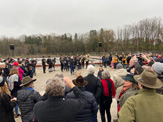
I'm back in Bavaria, where today a groundbreaking ceremony was held for Bernd Zimmer's fantastical project STOA169. A huge open hall of pillars in a bucolic landscape. each pillar made by an artist. I'm one of them. When I saw the list of the others I felt elated.
October 21, 2019 – "Python"
I wanted to start with "These days..." but at the back of my mind I had this vague memory I already used the Joy Division reference once, recently? Very recently it turned out. Oh well, so I can't say "these days one can no longer be surprised by the chaos created by people one used to think were sane". I'm referring to British politics. Of course. I just read a report on the latest bedlam in a Swedish paper which stated (in translation):
The best comment on the political culture that produced statesmen of Boris Johnson's caliber can be found in the Monty Python archive.
The writer offers this sketch as an example. Four days ago... it was updated.
October 6, 2019 – "Book(s)"
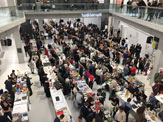

Two weeks ago there was a fair for artists' books in Berlin, this weekend there is one in Vienna. It opened Friday evening and I couldn't miss it: as can be see from the photo, it's right below my office in the drawing and printmaking department at the University of Applied Arts Vienna. Since one year our workshops and studios are located at the very centre of the freshly renovated building at Vordere Zollamtsstraße 7, next to the auditorium.
Neither fair is the only one of its kind in this year, in Berlin nor in Vienna. It is tempting to see a surging reaction against the digitalization of our lives. I hope this is true and will continue, once any fashion effect has passed.
As for me, I have become wary of owning fragile, rare books. I 'm no good taking care of them. I use books, in my hands they don't stay pristine for long. Yet I buy a lot (and always on paper). Since one year I'm trying to stick to a new regime: one book in, two books out. But it's hard. To select the books which should leave.
Anyway, yesterday arrived a book which I had ordered after reading about it in New York Times, where it was called "Belonging, A German Reckons with History and Home", by Nora Krug. The author is a German who lives in New York since 12 years, and the book is a curious mix of graphic novel, scrap book, family album, research narrative and artist's book which at times use a deceptively naive form. It relates how the author (born in 1977) begins to look into her family's past and how her search develops and what she finds. Yes, it is yet another book which relates to what happened between 1933-1945, but it's impact goes way beyond German guilt and ask questions which regard all of us. Especially now, given what certain politicians are trying to achieve. I ordered the German version (Krug wrote both, none is a translation), which is called simply "Heimat: ein deutsches Familienalbum" and I couldn't stop reading (and looking) before I had finished.
September 29, 2019 – "4:15:20"
Today I ran the Berlin Marathon again. This time it was hard. I had a problem with my left foot already before the start and it really began to bother me after 25 km. At that point it was raining as well. I'm very happy I made it to the finish line. Never give up.
September 23, 2019 – "Speech"

Today, Greta Thunberg addressed the UN in New York. The Guardian has published her speech here.
September 17, 2019 – "These Days"
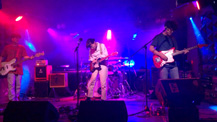
It's hard not to become obsessed, and therefore depressed, with the constant stream of news coming at you. I read to much. Papers. Although on screen (with one exception). It doesn't get better. But yes, you learn a lot. This morning I happened on Susan Sontag's classic essay "Fascinating Fascism" from 1975, which is about Leni Riefenstahl, but has a lot to tell us now as well. A little bit later, although I was supposed to work – but what is work? – I steeled myself and finally read Jonathan Franzen's "What if We Stopped Pretending?" It's really not very fun at all.
I prefer to go to concerts. See bands playing. Not to often, but every once in a while, with tickets bought in advance. You wait for the concert to come, and long for it. Yesterday I took Edvin and two friends to see my Korean favourites Say Sue Me in Badehaus, a smallish club near Warschauer Straße S-Bahn. And again, they were so good. I love this band. They have a perfect combination of songs and performance, endearing shyness and perfect self-confidence. Strikingly, the members seem to be perfectly equal to each other. Byung-gyu (who writes all the music) is an incredible guitarist, understated but oh so lyrical in every tone he plays. And he can play... anything. At one point, when a song ended, I was thinking "should I shout for Let it begin", a favourite song which I haven't seen live. I didn't have to: right at that very moment they started playing it. At the end, the singer Sumi (who writes all lyrics) plays a long four note solo which is just so ultimately expressive, although so easy that I could learn it. Say Sue Me deserves much bigger stages.
September 10, 2019 – "1989"
Last week I was in Stockholm for the opening of "1989" at Nationalmuseum. This museum is the counterpart to the Modern Museum, i.e. where the Rembrandts are kept. Earlier they would not have made a project about something recent, but times are changing. The museum has seen a thorough renovation and has become popular like never before.
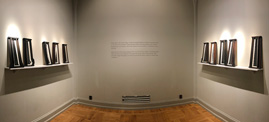
The exhibition attempts a cross-cultural perspective on the tumultuous year 1989, including lots of documentary photographs from Berlin and Beijing, but also various forms of visual art and design. This year was probably the high point of post-modernism in Sweden, mind you. Lots of language games. Some of it has shown itself to be political in retrospect, but far from all.
I have my own little room where I exhibit a series of photo-objects made in late spring 1989: "Les Cheminées d'Ivry". I had an exhibition at CREDAC, in Ivry-sur Seine which opened June 21. Less than three weeks after the Tienanmen crackdown. I will have been following the developments in China while I was making the works. Some four months later I was preparing my second one-man show at Galleri Engström, including a small catalogue. For this I wrote a short text which attempted to address what had happened in Beijing by using artificially positive language. It was supposed to be uncanny, and I do think it is. This text appears on the wall between the two rows of photo-objects. In its English version (in the catalogue it appeared in Swedish, English, Geramn and French) it goes like this:
Observers describing the atmosphere of the city, presented an image of smiling people filled with hope and enthusiasm. The square lay empty, traffic flowed freely, calm and order reigned throughout. It seemed certain that the future could be viewed with confidence.
My exhibition in Galleri Engström opened on November 4, 1989. Five days later the Berlin wall was opened.
August 10, 2019 – "Rave"
I watched Jeremy Deller's film "Everybody in the Place, An Incomplete History of Britain 1984-1992", which makes connections between "youth culture" (rave culture) and the political developments in Thatcher's Britain in the 80s and early 90s. It's a brilliant staging of what is basically a lecture, held before a multicultural class of 15-16 year old Londoners last year. Deller, utterly sympathetic in a striped sweater presents his case in front of the class, showing lots of film material from 80s documentaries and music programmes. The students are filmed in close-up as they react to the information and perspectives presented. Their questions are given ample space, the youngish and good-looking artist (he was 52 when the film was shot) offers his respectful responses.
I enjoyed the film and I think it is important, but I can't help thinking Deller's perspective offers lots of romantic nostalgia for his own youth (same age as the students) and protest was somehow more serious than today.
The film is sponsored by Gucci.
At one point, one of the students offers her insight that the role of pop music then, has been taken over by social media today.
August 7, 2019 – "Mother"
My mother died in her sleep, in the early morning of July 31. My father had passed on December 6, 2017. I am the oldest of three brothers.
July 20, 2019 – "Unfreedom"
At a friend's great birthday party recently, I was seated at a table where one of the other guests, who I did not know in advance, was a Ukrainian diplomat. Conversation was flowing when I said something about Ukrainian and Russian students getting along at the university in Vienna. I thought this an innocent remark, in a positive spirit. To my surprise, it triggered an intense and emotional reaction which you don't expect in quite that way from a high powered diplomat. Her position summarized very briefly: we are at war with Russia and you don't understand.
Which was true.
However, I understand the issue (and the diplomat's reaction) better now, after having finished reading Timothy Snyder's monumental and furious "The Road to Unfreedom", which I had just begun at the time of the dinner (a strange coincidence). It's subject is our scary political NOW and how it in many ways is being influenced, even manipulated, by a number of Russian thinkers and operators (one dead, the others much alive) which Putin has come to lean on. It's a book which relates both crazy theorizing and their real-life consequences. Which are not uplifting.
I have read a couple of Snyder's earlier books and this I think, is the scariest. Because of that NOW aspect, combined both with the very detailed telling of what actually happened and the equally detailed sourcing on what made that happen, which happened. Snyder is an historian, and as a writer he is both pedantic and passionate. The bulk of the book is devoted to Ukraine, and Russia's undeclared war on it. However, it doesn't stop there. Ukraine is next door to Europe and we do arrive in the White House eventually and at that point... No-one is safe.
July 11, 2019 – "Art Intelligence"
A review of my book "Making Prints and Thinking About It" has appeared in the prestigious American magazine Art in Print ("The Global Journal of Prints and Ideas", July – August 2019, Volume 9, Number 2). The title of Susan Tallman's review is "Art Intelligence: Jan Svenungsson on Making and Thinking". Is it good? YES! But sadly, only a very short version of the three page text is available online, if you're not a subscriber. Which I am, now.
When I started to work on this book, I had the idea that I would use my own work as a trigger for addressing all sorts of ideas beyond the actual work. And optimistic as I always am, whenever I launch a new project, I thought that maybe if I can write well enough I could reach an audience which will pick it up not because of me, but because of what happens in the book... And I thought that maybe, just maybe, I could get the book reviewed in one of those specialized printmaking magazines which I had first seen lying around in Niels Borch Jensen's workshop, years ago. Now, exactly this has happened, and I am happy. Sometimes you can get what you want, if you try your best.
I'd prefer to publish the whole review, of course, but do not have the right to do so. The short version gives an idea of the positive tone of the text, but there is more than that. Tallman has really understood what I was trying to do, and she adds observations which I hadn't particularly thought of, to the project. Which is what I am always hoping for, when I make something.
Like this quote, for example:
Though Svenungsson observes that “the joy of making precedes the joy of thinking,” most of his own work can be classed as “conceptual,” in the sense that its initiation point is usually a question about how images and ideas work. He is fascinated by incremental deviation and repetition—at what point, Ship-of- Theseus style, does one thing become identified as another? These concerns have motivated great printmakers from Rembrandt to Jasper Johns, and Svenungsson adds to them a 21st-century geopolitical awareness.
July 8, 2019 – "Britain"
I spent a few days in London with my son. We saw Babymetal at Brixton Academy, visited friends – and Edvin did his best to keep me from entering exhibitions. This was only partly successful. From the outset I had made clear I wanted to see the Cindy Sherman show at the National Portrait Gallery. It was a delight. It was the first retrospective show of hers that I have seen, where the work from the last twenty years did not look weaker than the iconic early pieces. Uncanny, yes, but not superficial. I could see the arc, and the changing engagement. We also happened on a show of flower still life paintings by Keith Tyson, at Hauser & Wirth, which I found exhilarating. Who would have thought? And why? Not necessarily because of the super-clever meta-games at play, but instead for a very pragmatic reason: because of the way the pictures were made. Because of the quality of paint, of colours meeting, pigments smeared, texture. As simple as that.
Soon after we passed a shop window (still on Savile Row) where I saw a shirt, which I ended up buying. The very correct shop assistant made polite small talk during the transaction. He asked if I wanted the receipt for VAT refund and I answered no "as you are still in the EU", which lead to continued polite conversation on this topic. I noticed his hands had begun shaking and I felt ashamed of myself.
Two texts illustrating why hands could be shaking, while considering this subject:
– a devastating portrait of Boris Johnson by the former editor of Daily Telegraph (the conservative newspaper for which Boris is still writing): "I was Boris Johnson’s boss: he is utterly unfit to be prime minister";
– and a New Yorker analysis of that same Johnson's strategies by the way of a spy novel from the 1960's: "Boris Johnson's 'Looking Glass Brexit' ". No less devastating, to Boris and to Britain.
June 18, 2019 – "Politics"
A couple of days ago I finally saw the whole of the video "Die Zerstörung der CDU" by youtuber Rezo. It's exactly one month since it was released and it has been seen 15 million times and counting . What's more, it has had real impact on the German political landscape – and nobody (apparently) saw it coming. I vote in the Swedish system and when my (15 year old) German-born son told me about Rezo a couple of days after the video's release, and before the European elections, I watched perhaps ten minutes of the total. Yet what I saw was so dense with information and argument and delivered in such a fast cut mode I told myself I'll see the rest later. For information and argument I much prefer reading to watching, it's about time management.
In the meantime the video took fire, went crazy viral and delivered exactly what is one of its themes: proof of CDU/CSU incompetence. (Here in how to answer well argued and well founded criticism delivered by a young person to a young audience).
And then they lost I don't know how many votes, as a direct result of Rezo's work. I'm fascinated by this initiative on a number of levels. First of all, it offers hope and new energy from an unexpected source, and that's the most important, of course. Yet I also much admire the way it was put together. For fiftyfive minutes Rezo is fast talking without any interruption (all pauses, except meaningful ones, having been cut out) and he is never adlibbing or improvising but sticking to a carefully prepared plan of exposing all what he thinks is wrong with establishment politics in Germany, in the form of CDU/CSU as well as SPD. (AfD being placed in a special hell of its own). He uses lots of slang and English words in his delivery, but his accusations are so well prepared you are never able to wave them away with a simple "he doesn't know what he's talking about". This effect is heavily underscored by a constant barrage of references to sources, listed separately. These references are superimposed directly on the screen, similar to some digarams and texts – and always very briefly. Which often makes the viewer stop the video, rewind 20 seconds, and watch a passage again. This also happens because you want to hear exactly what he said, once again. The speed being so high. The speed placing a demand on the watcher: you either focus completely on what I have to say, or turn me off.
The way this all works is like a highly effective hybrid between argument and entertainment. The audience is not enticed to continue watching in order to buy more stuff, but instead drawn into engaging with arguments about utterly important matters like climate change. Spending much more time on these arguments than they wanted before they started. And then – many (at least in the European elections)– acted in accordance.
One thing is sure,we will be seeing more of this method. Myself, I'm interested in what Rezo does next.
June 15, 2019 – "J & K"
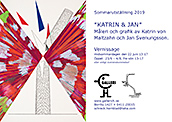
It doesn't happen often, but every once in a while I share an exhibition with Katrin, my wife. This time in Galleri CH outside of Borrby, at the south-east landscape of Sweden which is famous "for its light" under the name of Österlen. The show will open on Midsummer Day, June 22. As a Swede, I am supposed to be obsessed with Midsummer, and especially: that it doesn't rain (which it "always does"). However, after last summer's persistent tropical heat without rain for a month, this time I hope for more normal conditions. What used to be normal.
May 17, 2019 – "Knife"
This week I saw the same band play twice, Monday night in Vienna, Thursday night in Berlin. Shonen Knife from Osaka, Japan. I have written about them before, in 2011 and in 2014 and each time I see them play, I go in there with a little bit of a supportive partisan attitude, like "they work so hard and they deserve my support, independently of what I may be into at the moment", but I leave the concert on a high: convinced again that this band really is one of the greatest, ever. And so it was this week, of course. Monday was fantastic and yesterday my feeling was "even better". In 2014 I wrote that that year's lineup must have been the best ever, and yesterday I had the same idea... although the drummer Risa is new, and Atsuko is back on bass. Naoko is always there. The earliest existing recording with this band is three songs from their first gig ever, on April 17, 1982. It's original and very primitive. Naoko and Atsuko and their friend Michie, who left in 1999. Go figure. Time.
May 6, 2019 – "Magiciens"
I'm reading a piece about (according to the current director of the Tate) "the most famous exhibition that nobody saw": "Les Magiciens de la Terre", which opened at the Beabourg and the Grand Halle de la Villette in Paris thirty years ago this month. 30 years ago... it's not true that nobody saw it, because I did and I remember it well. It was a few weeks after the opening, together with Pontus Hulten and the students (of which I was one) and teachers of the Institut des Hautes Etudes en Arts Plastiques. Jean-Hubert Martin (its instigator and curator) came to one of our sessions to discuss his project and then we went there together. I remember being fascinated by the whole of the exhibition, but not yet caught... An illustration to the article I'm reading now shows the juxtaposition of a Richard Long mud circle and a floor installation by aboriginal artists from Yuendumu in Australia's Northern Territories. I don't remember seeing this, which is odd, because less than ten years later this kind of art would become one of my passions. In 2010 I even visited Yuendumu, briefly. Jean-Hubert Martin, who I had already met several years earlier, in Man Ray's studio, I would see again, in February 2011, at a conference on Aboriginal Art at the Ludwig Museum in Cologne. I wonder what he is doing now?
May 4, 2019 – "Chaos"
This morning I finished a book which has made a very strong impression. I had never heard about its author before I happened to read about it in a column by Simon Kuper in Financial Times (which came with a flight). This was a few days before it was released and I did what is so easy to do: I clicked on Amazon – and received the book on its first or second day. That was more than a month ago. It's been slow reading, not because the book is boring, but because it's so good – and so hard on one's wish to just relax and think "it will turn out OK, after all".
"Les ingénieurs du chaos", by Giuliano da Empoli, published by JC Lattès. Da Empoli is a French political scientist who runs a think tank in Milan and was an adviser to Matteo Renzi. In the book he takes apart and explains the techniques – and the science – used by the rising populist politicians in Europe in a matter-of-fact way which I haven't seen with this precision before. Plenty of references to English/American, French and Italian sources. None of the so often irritating French habit of abstract philosophizing.To read about how Italy's Five Star Movement came to be is especially shocking: it was put together by the head of a web-marketing company (Gianroberto Casaleggio) who controlled it completely until he died in 2016. Now his son is running this party dedicated to "direct democracy". Beppe Grillo was just a figurehead. This is one part of the picture being laid out with so many surprising details (yes: Brexit, Gilets Jaunes, Orban, Bannon, etc) and a general analogy drawn to the shift which once happened when newtonian physics (rational, law-bound) were replaced by quantum physics. What is the overall message? Not that one party is having the solution, rather that we are experiencing a completely new situation for democracy which demands new thinking if it is going to be saved. No way back, sorry. I would be surprised if there is not soon an English translation, but for now this long quote (the final pages of the book) will need to be in its original French:
D'une certaine manière, la démocratie libérale est une construction newtonienne, fondée sur la séparation des pouvoirs et sur l'idée qu'il est possible, pour les gouvernants et pour les gouvernés, de prendre des décisions rationnelles, basées sur une réalité plus ou moins objective. Poussée à son extrême, c'est l'approche qui a pu conduire, au lendemain de la chute du mur de Berlin, Francis Fukuyama à proclamer la fin de l'Histoire.
Avec la politique quantique, la réalité objective n'existe pas. Chaque chose se définit, provisoirement, en relation avec quelque chose d'autre et, surtout, chaque observateur détermine sa propre réalité. Dans le nouveau monde, comme disait l'ancien président de Google, Eric Schmidt, il est de plus en plus rare d'accéder à des contenus qui ne soient pas taillés sur mesure. Les algorithmes d'Apple, de Facebook, et de Google lui-même font en sorte que chacun d'entre nous reçoive les informations qui l'intéressent. Et si, comme le dit Zuckerberg, nous sommes davantage intéressés par un écureuil agrippé à l'arbre devant chez nous que par la faim en Afrique, l'algorithme fera en sorte de nous bombarder de nouvelles sur les rongeurs du quartier, éliminant ainsi toute référence à ce qui se passe de l'autre côté de la Méditerranée.
Ainsi, dans la politique quantique, la version du monde que chacun de nous voit est littéralement invisible aux yeux des autres. Ce qui écarte de plus en plus la possibilité d'une entente. Selon la sagesse populaire, pour s'entendre il faudrait " se mettre à la place de l'autre ", mais dans la réalité des algorithmes cette opération est devenue impossible. Chacun d'entre nous marche dans sa propre bulle, à l'intérieur de laquelle certaines voix se font entendre mais pas d'autres et, certains faits existent mais pas d'autres. Et nous n´avons aucune possibilité d'en sortir et encore moins de l'échanger avec une autre personne. " Nous semblons fous les uns pour les autres ", dit Jaron Lanier, et c'est bien vrai. Car ce ne sont plus nos opinions sur les faits qui nous divisent, mais les faits eux-mêmes.
Dans la vieille politique newtonienne, l'avertissement de Daniel Patrick Moynihan, " Chacun a droit à ses propres opinions, mais pas à ses propres faits ", pouvait encore avoir de la valeur, mais dans la politique quantique ce principe n'est plus viable. Et tous ceux qui s'évertuent à le réhabiliter contre les Salvini et les Trump sont destinés à perdre.
La politique quantique est pleine de paradoxes: des milliardaires deviennent les porte-drapeaux de la colère des déshérités, des décideurs publics font de l'ignorance un étendard, des ministres contestent les données de leur propre administration. Le droit de se contredire et de s'en aller, que Baudelaire invoquait pour les artistes, est devenu, pour les nouveaux politiques, le droit de se contredire et de rester, soutenant tout et son contraire dans une succession de tweets et de directs Facebook qui construit, brique après brique, une réalité parallèle pour chacun de leurs followers.
Dès lors, s'époumoner pour réclamer le respect des vieilles règles du jeu de la politique newtonienne ne sert pas à grand-chose. " La mécanique quantique, a écrit Antonio Ereditato dans son dernier livre, est une théorie physique indigeste parce qu'elle entre en conflit de manière dramatique avec notre intuition et avec la manière dont nous avons été habitués à voir le monde pendant des siècles. " Et pourtant, les physiciens n'ont pas baissé les bras. Armés de patience et de curiosité, ils ont commencé à explorer les coordonnées du nouveau monde dans lequel les découvertes de Max Planck et compagnie les avaient précipités.
En politique, cette attitude coïncide très exactement avec l'esprit invoqué par un autre grand réformateur, John Maynard Keynes, quand, au lendemain de la Première Guerre mondiale et de la révolution soviétique, il s'adressait aux jeunes libéraux réunis pour leur Summer School :
" Presque toute la sagesse de nos hommes d'état a été fondée sur des présupposés qui étaient vrais à une époque, ou en partie vrais, et qui le sont chaque jour un peu moins. Nous devons inventer une nouvelle sagesse pour une nouvelle époque. Et en même temps, si nous voulons reconstruire quelque chose de bien, nous allons devoir apparaître hérétiques, inopportuns, dangereux et désobéissants aux yeux de tous ceux qui nous ont précédés. "
C'est de cet esprit, à la fois créateur et subversif, que devront s'emparer tous les démocrates pour réinventer les formes et les contenus de la politique des prochaines années, s'ils veulent être capables de défendre leurs valeurs et leurs idées à l'âge de la politique quantique.
April 26, 2019 – "Angles"
I added three pictures from the small show of prints in Borch Editions, which went with the book launch mentioned below. What stroke me was watching "Haze" completely change its aspect due to from which angle you approached it. It's an effect caused by the metallic colours, of course – and it's not visible in the photographs. Which is as it should be. Make it real.
April 24, 2019 – "Haze"
My launch in Berlin two weeks ago, for "Making Prints and Thinking About It" went really well. The discussion with Andreas Schalhorn flowed without any hesitance. I had worried that the book having been written in English while our talk was held in German would disturb my thoughts, but no problem. Lots of people came. Afterwards I noticed I had forgotten to add my two latest prints to this site, which has now been fixed. They are "Haze" and "Blut". Suitable titles for disturbing times. I need – we need – to hold on to positive and productive thoughts.
"Haze" has an unusual conception. It was printed from the woodblocks prepared for "First Chimney – Stockholm" back in 1996-97, but this time using only metallic colours, which gives it a really strange appearance, changing with the angle you watch it from. Here's how I tell its story in the book:
To my surprise, there was to be one more print still. Years ago, Niels Borch Jensen had called from Copenhagen and asked if I wanted to retrieve the blocks for my 1996–98 chimney woodcuts. If not they would be thrown away. I said no, and didn’t think more of it. There is no reason to keep the matrix once the edition has been produced.
In late April 2018, Niels gave a small dinner at a restaurant in Berlin, and I sat next to Julie Dam.
She mentioned in passing that she had come across the blocks in the workshop recently. “But they were thrown away,” I protested. Julie insisted that she was sure she had seen them. Then and there, it came into my head that if indeed this were true, I must make another edition of the first chimney woodcut, using only metallic colors. I have no idea why, or where this impulse came from, nor why it seemed so self-evident to me. It can be more fun not to ask. I told Julie and Niels about my decision. A week later Niels called and confirmed that the blocks were indeed still there. And thus on 11 July 2018 I find myself back in Niels’ workshop for the proofing of the old-new print. Julie and the others are on summer holidays, only Niels is working. Instead of cyan, magenta, yellow and black, he inks the blocks with silver, copper, gold and graphite. I have no clear idea what this will bring, but I like what I see. After test-printing the blocks in several different sequences, we decide on the best balance. Good job. Now, what does it all mean?
I was watching Niels print the same blocks on the same press in the same room, as I had at the proofing session in early 1997, more than 21 years before.
This time my son was present. Edvin was born eight years after I had begun cutting the first of those blocks. His promise to the world is still unlimited, as should be his expectations. Yet a print made that day might well survive all of us present at its making, potentially causing reactions and stirring feelings that neither he, nor Niels, nor I will ever know of.
April 16, 2019 – "Fire"
Nôtre Dame burning. It's construction began in 1163 and it was inaugurated 1345. 182 years. Imagine construction on – something – starts to day and continues to 2201. Possible?
April 11, 2019 – "Books"
Tonight, in Pro qm, in Almstadtstrasse 48-50 (in Berlin) at 20:30 will be presented the catalogue to Busan Biennale, which finished half a year ago. Better late than never. Some of the artists will say or show something. I'm planning to show an animation of my maps and predict the future...
Then on Saturday (13.4) there will be the Berlin launch of my book "Making Prints and Thinking About It", at Niels Borch Jensen's gallery in Goethestrasse 79. At 18:00 I will have a conversation about the book and the issues it presents, with Andreas Schalhorn, from Berlin's Kupferstichkabinett, and Niels himself. I'm very happy about this opportunity, and excited too. The discussion will be in German, although the book is in English. I just hope I will find all the words I need, when I need them
April 10, 2019 – "Difference"
In a short piece in Frieze, titled "The Corrosiveness of Identity Politics in Art" by the wise Susanne von Falkenhausen, I pull this quote:
Identity – once the object of political and social debates in terms of difference, hybridity and the demand for mutual respect – has become static. Diversity takes the place of difference. Identity becomes a property to be defended, legitimizing its owners to strike and to silence trespassers.
The key word ,here is "static". The key sentence is the last one. But please, read the whole article. And don't forget: art mirrors wider society.
April 6, 2019 – "Impact"
In the New Yorker I read a long piece about a geological/paleontological excavation in North Dakota. "The Day the Dinosaurs Died". Not usually a dramatic subject, but in this case very much so. Both because the writer goes all out Indiana Jones in his portrayal of his lone digger hero (which is controversial) but more so because of what is actually being related. The site apparently contains geological sediments and a jumble of fossils which, according to the story (and a first scientific paper published last week) make it conceivable to see this configuration as a direct trace of the asteroid impact 66 million years ago, which in one smash completely changed the conditions for life on earth and extinguished countless species. In the sediments on this site are plenty of very small drops of what once was glass: "ejecta spherules". These are direct traces of the enormous explosion. And here, these drops have been found also within the gills of fossilized fish. Which would mean, if the theory holds, that these fish died as a direct consequence of the impact. Within an hour.
March 29, 2019 – "Mayday"
Today was the day that Britain was going to leave the European Union. Not so fast. They still haven't agreed among themselves on how. Instead, the parliament voted down the government's deal also today. For the third time. The same deal. Three times rejected. Imagine if instead they'd repeat the referendum three times. Why not?
March 27, 2019 – "Artistry"
I'm completely bewitched by the hourly reports from the British political process. And I don't mean it in a good way. Brexit. It's a monumental tragedy, and one wishes nothing so much as finding a way to simply turn it off. Like a reality soap you don't want anymore. Turn it off and it is gone. Today I happened on a podcast from The Guardian called "The reality of reality TV". While focused on the shenanigans and manipulations of the producers of a show called "Love Island" it also made the point that this kind of shows have a wider cultural impact. That, in effect, this is art (if that's the right word?) which matters and has an impact on society as a whole. Bad luck for society. At least one such "artist" has reached very far indeed. One should be careful with what one wishes for. Artists turned politicians is not necessarily a safe bet. Germany knows this as well
March 17, 2019 – "Brick"
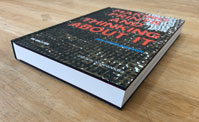
With everything else going on, now has arrived the first copies of the book I have been working on for soon two years: Making Prints And Thinking About It. And which I have written about here several times already, because the project has so occupied my thoughts. Waiting to be confronted by the result of your efforts is a nervous situation. All that work, now fixed in a physical analogue form. How will it feel? Well, my first impression is, that it feels fantastic! The book is like a brick, it has an incredibly solid feel. I never had this impression from a book before, never mind my own book. Apparently the hardcover and the pages have all been cut together, forming this one block. Not bad, not bad at all.
I'm looking forward to reading my text again, because on April 13 I will have a public discussion on its topic, with Andreas Schalhorn from Berlin's Kupferstichkabinett. I do indeed address more than my own work in this book, it's about a far wider picture and my wish is that it will have some reach.
March 16, 2019 – "Ostalgie"

I met Henrike Naumann i Busan in September. I hadn't heard of her work before and was astonished to see her huge installation of readymade post-Memphis furniture, interspersed with video monitors with scrappy videos showing (what looked like documentary) shots of German skinheads hanging out and talking about their exploits. What was this???
Talking to her in Korea and seeing another couple of shows later, has made me realize how Henrike has her finger on the pulse of one both sad and murky aspect of what is bubbling right now. Working strictly with the German context, and more precisely, the former-GDR-context, she lays naked many of the mechanisms behind the rightwing populism of the moment. It is not a pretty sight. It's nauseating. Like in the installation view here, from her huge show "Ostalgie", at KOW in Berlin. Important, scary stuff.
March 15, 2019 – "Jeanne d'Arc"
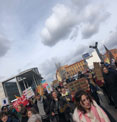
This morning I read a "call for applications" for students, scholars and practitioners in the fields of art. It is for a gathering this summer which will focus "upon states of consciousness". And then it gets precise. Listen to this:
As we have witnessed firsthand in the 2016 U.S. election, the political potential stored in the complex networked analytics of information and their neural analogues are now being fully engaged as apparatuses of control. Economies of attention and dis-attention, click bait, cloud analytics, memes, social media and fake news have now taken center stage in the process of subjectivation and the interiorization of domination. Could the spreading wave of Populism worldwide be the result of forms of embodied and extended cognition linked to contemporary neoliberal apparatuses? The central thesis of this year's program posits that these are the initial constituents and first signs of an impending crisis that define a later stage of cognitive capitalism.
There is more, but I think this is more than enough.
When I read language like this I feel afraid. I think it's safe to assume the people behind this word salad identify themselves as left and progressive. Fighting the good fight. We probably agree on a lot of things. But WHY dress your political insights in this kind of unreadable gobblydygook? Whoever has an important message should make every effort to communicate it AS CLEARLY AS POSSIBLE. In order to convince more people than your own group of intimates, who are already in the room.
The other day I watched the 16 year old Swedish climate campaigner Greta Thunberg give two presentations. At Davos, last month, and last year a TED talk in Stockholm. She is squirming in the light, unable to look straight in one direction, but no matter: her language, her message, her cause – is ultra clear. Not one word extra, not one word not hitting you hard, making you question yourself and everything which is going on, in the most serious and profound way. I feel rattled.
A couple of hours ago I made a run through Berlin. Crossing Luisenstrasse, close to the government area, I came across a student demonstration inspired by Thunberg's initiative. Like all over the world, today, March 15, 2019. On one banner I read:
Wir sind hier – Wir sind laut – Weil IHR unser Zukunft klaut.
We are here – We are loud – Because YOU steal our future.
February 24, 2019 – "Networking"
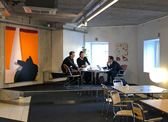
I'm fascinated by this photo, which I shot with my phone (I had forgotten to bring a real camera) before the opening last Wednesday, in the lobby of A house in Stockholm. The exhibition, consisting of nine "Paintings" from 2011-2017, had been installed by James Flach without any input from me. It's certainly no white cube, but the entrance space to the famously brutalist building which until recently housed the Stockholm Technical University School of Architecture. It's well known as possibly the ugliest building in the capital. Since 2014 the School has new lodgings, and its former home has become a startup hub, where lots of hyperactive smaller companies rent spaces and engage in frenetic networking in the lobby cum café, where now my paintings are hanging. I didn't expect this to be working as well as it does. Arriving there two hours before the opening there were coffee-fueled meetings going on all over the place, but the funny thing was, that instead of feeling bad for my paintings ("oh, why did I ever leave the White Cube?") I saw them being participants, not decorations. Hanging out among my works in that crowded space (the opening was well visited) I registered new aspects to what I had done, and felt grateful.
February 20, 2019 – "Free"

In 2007 I wrote a little book which has proven to be quite popular within its field. An Artist's Text Book aims to support artists who struggle with the ever increasing necessity of writing text in addition to their visual work. More than that, it wants to show there is a lot to gain once you engage with writing in an earnest way. Which means, of course, steering free from IAE... Anyway, after a friend in South Korea had tried to order copies of the book I learned that the second edition had been sold out. I was then asked by the publisher, the Finnish Art Academy, whether instead of printing a new edition, the book could now be made available for free download on the internet. I first said no, because I prefer books to be tactile experiences. I then reconsidered. Yesterday the download link was debuted. Do go here.
February 18, 2019 – "Trump"

In two days I will be in Stockholm for a exhibition organized by gallery Flach in another location; called A house. Nine "Paintings" from 2011-2017 will be shown. To accompany them I present a new version of the text I wrote for the exhibition of "Paintings" at Bror Hjorths Hus 2017. In this I reflected on the relationship between my work (paintings) and the situation in the world "outside". It was written after President Trump had been elected, but before his inauguration.
Now, two years later, I felt it was appropriate to return to this text. I have abridged it and added an introduction. It is here (in Swedish).
February 13, 2019 – "Printing"
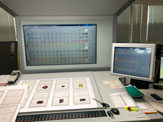
I'm in Wolkersdorf, just outside Vienna, keeping an eye on the hightech offset printing of my book "Making Prints and Thinking About It". On the printer's control table in this photo, you can see a sheet with photographs of my book of etchings "Parad". In my new book I describe in detail how this book was made back in 1991; how I first made a dummy in which I pasted snapshots of existing work, the b/w photos colored with watercolor. I then worked very hard together with Niels Borch Jensen to render in combined photoetching and aquatint the exact effect of my slapdash images in the dummy. One of the images which appear in Parad (front left in the photo above) was based on a photograph of a magazine reproduction of a framed photo which, in its turn was a rephotographed manipulated photograph of a photo I saw in a museum.
I repeat: One image printed today is a reproduction of a photo of a page in a book with a gravure which reproduces a handcolored photo of a printed reproduction of a photo of a manipulated photo of a photo in a museum.
Get it?
February 12, 2019 – "The Mix"
(two days ago I happened to listen to Kraftwerk for the first time in ages. I was astonished how well they hold up)
I wanted to note three occurrences which gave this day its character. Like so many days: torn in all directions.
First: last night Katrin and I watched the whole of Shonen Knife's recent live DVD, "Alive in Osaka". K will spend a good part of spring in Japan, but while she is working in Kobe (close to Osaka, SK's hometown) she will miss them play at home, because SK will tour in Europe – and I will see them (for the fifth time) in Berlin. Now we compensated in advance. Shot professionally but on a low budget in a small club, Naoko and her sister Atsuko on bass and new drummer Risa went through a long list of songs with that incredibly contagious and wonderful enthusiasm they produce – always. It's quite a wonder. Naoko and Atsuko formed the group at the end of 1981 and Naoko has been at it ever since (Atsuko has had a break). Fiercely independent. There exists a recording (utterly and endearingly primitive) from their first concert ever in 1982 and here they were at the end of 2017. Doing it. Naoko doing her life's work. It's deeply impressive (and the music is great, think nothing else) and makes you think about your own... life's work.
Second: this morning I read an article in the Guardian titled "Climate and economic risks 'threaten 2008-style systemic collapse' " , and the preamble goes "Environmental and social problems could interact in global breakdown, report says".
Third: a couple of hours later, while in the studio painting, I read an email from one of my students, who is from a country outside the EU. This morning X finally received a student visa. That doesn't sound very dramatic perhaps, but it has been an absolute fight against the Austrian authorities since summer. Again and again X had submitted all the paperwork, meticulously prepared, correct and complete, only to be rejected based on deliberate misreadings by the immigration authorities. Having no more time left on a tourist visa X was forced to leave Austria before the semester was over, while efforts on X's behalf continued. I wasn't able to do much, but a superbly skilled university colleague took up X's case and was able at a crucial moment to meet with the recalcitrant public servant and physically point out exactly where the deliberate misreading of X's documents took place. It still took another month, but eventually they were forced to relent. Without the superior skills of my colleague it would have been completely hopeless, of course. As it will be for so many others, now that Europe is closing its doors.
January 29, 2019 – "Reading"
Does Journalism Have a Future?
The New Authoritarians Are Waging War on Women
January 22, 2019 – "Brave & New"
How to make art that matters politically? Today, right now? How do you position yourself in relation to the power, when the power is busy breaking rules? By breaking the rest of the rules? I read an interesting article comparing "1984" to "Brave New World", which notes that:
Orwell did create some technological innovations for his future world, but in essence his Nineteen Eighty-Four is a deep look into the of already existing totalitarian societies.
while:
Huxley’s dystopia was the other sort of speculative fiction from Orwell’s: not a deep burrowing into the present, but a projection of existing trends into the future. He genuinely was trying to think about what the future would be, if things carried on in the direction they were headed. He was well placed to see trend lines in many of the sciences and made good guesses about where they were going. As a result, we can make a strong claim that it is he, and not Orwell, who did a better job of predicting modern life in the developed world.
Is this an example to follow? Is it possible? Do I want to?
January 20, 2019 – "Pleasure"
What is pleasure? It can be many things, of course, but right now while waiting in an airport and reading an interesting but complicated text, I entered a state of mind where suddenly you do lots of cross connections between thoughts. Where they stop being repetitive and shackled and instead start jumping around – hitting targets. I keep interrupting my reading to make note after note about the different issues brought up. And I think: this is how it should be, this is how you can move forward. This state of mind is what I am always after, when I'm alone and at work, but it keeps getting harder to reach. A main reason being never ending to-do lists which are so effective at limiting one's scope for cross-disciplinary thinking.
January 16, 2019 – "Slow-motion"
This morning, all media full of Theresa May's historic loss in the British parliament. The Brexit plan her government has negociated with the EU was thouroughly rejected. It was expected, of course, but nevertheless it is one more dramatic step towards catastrophic national self-mutilation. Or not, if indeed this was a necessary step on the road towards a second referendum. Nobody knows which. It's like watching an on-going car crash in slow motion.
I don't remember having had quite the same experience of watching a society taking one step wrong after another – while it is going on, instead of reading about it after the fact. Worse would be living in that society, but it is a faint comfort, because we are all interconnected. And... it is not just one place performing this dance.
I believe the background for this dysfunction is everyone's accelerating fixation on their own feelings in their own bubble. Social media's feedback loop for the individual, and delusions of manipulative grandeur for politicans. The result is fragmentation and falling apart. We need to change these mechanisms. Together.
January 11, 2019 – "Late start"
I thought I'd start with a passage about listening to Beethoven and thinking about creating, from the book I'm reading right now: Assymetry by Lisa Halliday. I then found the quote too romantic and decided not to.
I don't know where to start the new year. I'm looking for a shape to follow. There is so much going on, so many complex problems to access. So much trying to decide where one's own responsibility is centred. No clean solutions.
I do listen to music and I do create. I also think a lot about what it is I listen too and what role it plays. And yes, I do have so many questions about what it means to create in the present situation – and how – and where the creation should be positioned.
